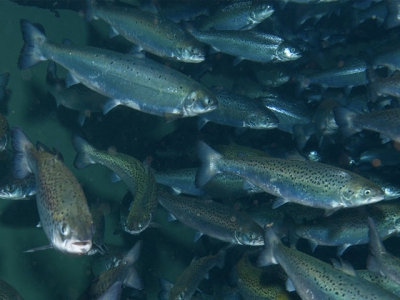Preventing and controlling salmon lice in commercial aquaculture

A cohort study of commercial salmon farms in Norway explores different prevention and treatment strategies for salmon lice and finds that habituated cleaner fish can keep lice at bay despite fluctuations in temperature and wind currents.
Keeping salmon lice-free is a major goal for the aquaculture industry. Photo © Stofn Fiskur
A recent study in the Journal of Fish Diseases follows the delousing efforts of multiple commercial salmon farms in Norway over three production cycles. The researchers compared the effectiveness of the different control strategies: lice skirts, coordinated salmon production and cleaner fish.
Their results confirmed that cleaner fish can delay the growth of salmon lice and keep their numbers below the legal limit. However, the researchers noted that there’s a critical window where the cleaner fish can be most effective. Data from the fish farms suggest that cleaner fish deployed early in the production cycle (during the first year) were most effective at keeping lice at bay.
The study
For this study, researchers analysed data from commercial salmon farms near the Norwegian island Froya from 2013-2018. They examined three consecutive production cycles and tracked the overall level of sea lice at different sites. They also tracked delousing methods and the preventative measures taken by the farms. The researchers also monitored temperature and wind patterns in the region to determine the role these contextual factors played in lice infestations.
Findings
Temperature readings from the study stayed within normal ranges – despite two cold snaps in the spring of 2013 and 2018. Researchers identified a positive correlation between temperature and sea lice infestation from the data. This means that as water temperatures rose, the levels of sea lice increased as well. This finding suggests that fish farms should monitor temperatures and increase lice surveillance efforts during warmer months.
Researchers observed fluctuating levels of sea lice during the project. In general, they found that lice levels were highest during the second production cycle (between 2015-2016). There could be multiple reasons for this: lice in early stages of development during the first phase of production could mature and reach a higher density during the second phase. The increased lice levels can also be attributed to the warmer temperatures observed during the second production phase.
Recommendations
When it came to preventing outbreaks, the researchers concluded that coordinated salmon production wasn’t the best method. Based on their observations, coordinating production meant that if an infestation began on one site, it could easily spread to the surrounding area. Coordinated production could also increase the infection pressure for the sites in the area – making it more difficult for infected sites to bounce back to legal levels.
From 2013-2018, many of the farms adopted lice skirts as a preventative strategy. Based on the study results, lice levels decreased in the pens after they were used. However, the researchers couldn’t conclude if the decreased lice levels could be entirely attributed to using the skirts. They stressed that more research needed to be done in the area before concrete recommendations could be made.
Lumpfish

Habituated lumpfish were able to keep sea lice levels below the legal limit. Photo © Terje Aamodt, Nofima
Based on the data, cleaner fish were an effective prevention and treatment method for salmon lice. Cleaner fish like wrasse and lumpfish could delay the growth of lice and keep their levels below the legal limit. However, cleaner fish had to be deployed at the right time for them to keep lice levels in check.
The data showed that wrasse and lumpfish should be deployed during the first year of production. This would give them time to acclimate to their surroundings. Keeping the tanks stocked with 4 percent cleaner fish with 96 percent salmon reduced the risk of reaching 0.1 adult female lice per fish by 62 percent when compared to pens with lower levels of cleaner fish. The therapeutic effect was larger when the 4 percent tanks were compared to those without cleaner fish.
The researchers also demonstrated that cleaner fish have a different effect on lice levels depending on the lice’s developmental stage. Some research indicates that lumpfish prefer to eat larger lice, making them less effective against early-stage outbreaks. Because of this, the researchers concluded that cleaner fish should not be viewed as a silver bullet when it comes to preventing salmon lice.
Background
Delousing methods in commercial salmon farming are rapidly changing. Salmon lice are becoming more resistant to conventional remedies like bath treatments and oral supplements. There are also increasing concerns over chemical residues from traditional delousing methods remaining in the environment. Due to these challenges, commercial aquaculture ventures are investing in alternative delousing methods and engaging in more early prevention efforts.
Có thể bạn quan tâm
 Method developed to protect carp from ammonia
Method developed to protect carp from ammonia Veterinarians from RUDN University in Moscow, Russia, have developed a way to increase the resistance of carp one of the most common fish raised
 Supplemental β-glucan may mitigate enteritis in farmed trout
Supplemental β-glucan may mitigate enteritis in farmed trout Adding β-glucan to the diets of farmed trout may support weight gain, fish performance and feed efficiency while reducing symptoms of enteritis, say researchers
 Researchers look to new ways to tackle CMS in salmon
Researchers look to new ways to tackle CMS in salmon Experts from the Scottish aquaculture industry, academia & veterinary diagnostics, are aiming to develop a new early warning system for cardiomyopathy syndrome